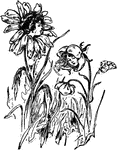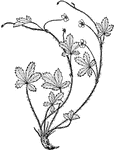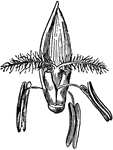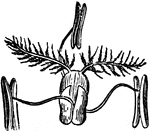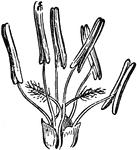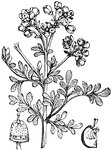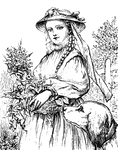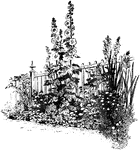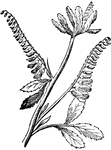
Melilot
"A genus of clover-like plants of the natural order Leguminosae, with ternate leaves, differing from…

Purple Foxglove
A biennial herb native to Europe. Its leaves and flowers are poisonous to humans and some animals.

Crown
"The truly beautiful crown of Edward II as it is represented in his effigy, was formed of four large…

Heath
"Erica cinerea. The English form of a name given in most Teutonic dialects to the common ling or heather,…

Heath
"Calluna Vulgaris. The English form of a name given in most Teutonic dialects to the common ling or…
Sulphurator
"Sulphurators are instruments for distributing flowers of sulphur, for the purpose of destroying mildew.…

Epps's Sulphurator
"Sulphurators are instruments for distributing flowers of sulphur, for the purpose of destroying mildew.…

Rest Harrow
A common European under—shrub. Generally low spreading, and much branched, bearing, pink papilionaceous…
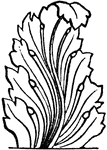
Acanthus
"The name given by the Greeks and Romans to the plants sometimes called Brancursine, of which it is…
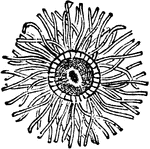
Actinia
"A genus of marine animals closely allied to the Hydraform Polypi, but of much greater size, and always…

Actinia
"A genus of marine animals closely allied to the Hydraform Polypi, but of much greater size, and always…

Allaria Officinalis
"Allaria officinalis. a, upper part of stem, with leaves and flowers; b, extremity of a branch, in fruit."…

Amaranth
"A genus of plants of the natural order Amaranthaceae. This order contains nearly 300 known species,…
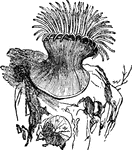
Anemone
"A popular name of the species of actinia and some other Actiniadae. It seems to have been first applied…

Anemone
"A popular name of the species of actinia and some other Actiniadae. It seems to have been first applied…
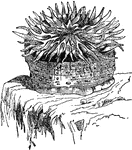
Anemone
"A popular name of the species of actinia and some other Actiniadae. It seems to have been first applied…

Arbor Vitae
"A genus of plants of the natural order Coniferae, allied to the cypress, and consisting of evergreen…

Arnica Montana
"A genus of plants belonging to the natural order compositae, sub-order Corymbiferae. The flowers of…
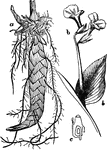
Arrow-root
"Arrow-root (M. arundinacea). a, tubers; b, leaf and flowers; c, stamen and style." — Chambers'…

Common Ash
"A genus of trees belonging to the natural order Oleaceae, and distinguished by very imperfect flowers,…

Common Ash
"Common Ash. a, a branch with leaves; b, flowers; c, fruit (on a considerably larger scale than the…
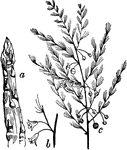
Asparagus
"Asparagus. a, a young shoot; b, flowers; c, the upper end of a stem, showing branches, leaves, and…

Alfred's Jewel
"An ornament of gold, apparently intended to hang round the neck, found in Athelney, and now in the…

Balsam
"Balsam (Impatiens Noli-me-tangere). a, top of stem with leaves and flowers; b, ripe fruit unopened;…

Batatas
"A perennial plant with long creeping stems, heart-shaped leaves on long stalks, and variously lobed,…
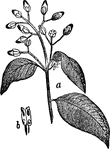
Cinnamon
"Cinnamon: a, end of branch, with leaves and flowers; b, four-celled anther." — Chambers' Encyclopedia,…
Colchicum
"A genus of plants of the natural order Melanthaceae. The species, which are few in number, are stemless,…
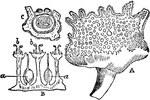
Contrayerva
"A medicine once in much repute against low fevers, and as a mild stimulant and diaphoretic, and still…

Cowslip
"A common native of pastures in England and many other parts of Europe, although rare in Scotland, a…
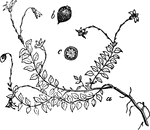
Cranberry
"Cranberry (Vaccinium palustris): a, part of stem and branches, with roots, leaves, and flowers; b,…

Cress
"A name given to many plants, of which the foliage has a pungent, mustard-like taste, and is used as…

Crest-Tiles
"In architecture, an ornamental finishing, either carved in stone, or of tiles running along the top…
Crockets
"In Gothic Architecture, are projecting leaves, flowers, or bunches of foliage, used to decorate the…

Crockets
"In Gothic Architecture, are projecting leaves, flowers, or bunches of foliage, used to decorate the…

Crowberry
"A small procumbent shrub, of the natural order Empetraceae, a native of the northern parts of the world,…
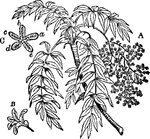
Cusso
"Cusso: A, a branch, with leaves and flowers; B, a flower seen laterally; C, a female flower; a, b,…
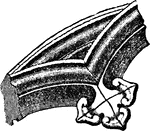
Cusp
"Cusp, in architecture, is the point formed by the meeting of two small arches, or foils, in foil arches,…
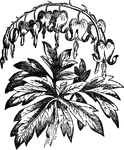
Dielytra
"A genus of plants of the natural order Fumariaceae, in appearance and habit much resembling fumitories…

Dogbane
"Dogbane. a, end of branch, with leaves and flowers; b, a flower cut open; c, fruit." — Chambers'…

Jasmine
"Botanically Jasminum, a genus of shrubs or climbers constituting the principal part of the natural…
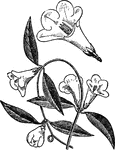
Gelsemium
"The plant known in America as the "Carolina jasmine" is not a true jasmine. other hardy species commonly…
Egyptian Charm
"A small porcelain cylinder ornamented with interlaced lotus flowers in intaglio, having a ring for…

Border
A heavy border which shuts out a bleak field. In front of this border is an ideal place for flowers.

